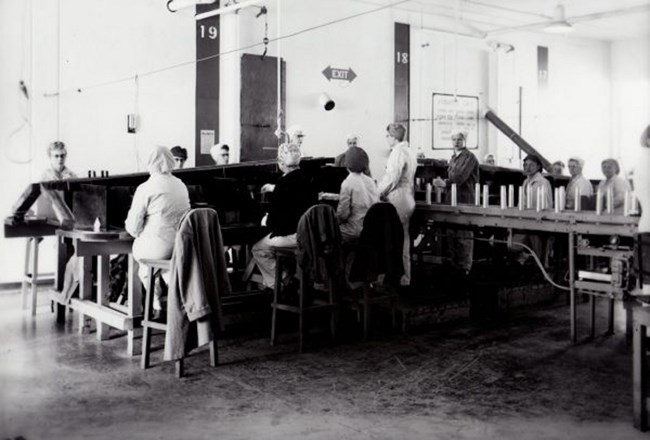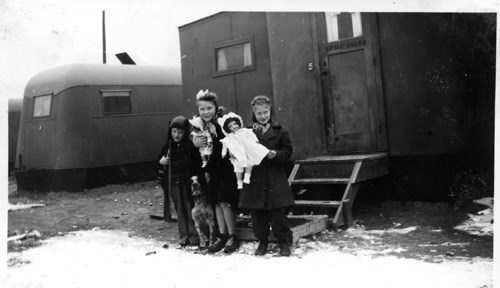Last updated: February 7, 2024
Article
Hastings, Nebraska

U.S, National Archives and Records Administration
American World War II Heritage City
Before World War II Hastings, Nebraska was a small city struggling to recover from the Great Depression and a population decline. With the start of the war, communities emerging from the Depression saw an opportunity for economic recovery through war production. The announcement that Hastings would be getting a defense facility was greeted enthusiastically by many city residents who recognized the economic and growth potential it offered to the surrounding community.

U.S. National Archives and Records Administration
The new defense facility, Naval Ammunition Depot Hastings (NAD Hastings), was the largest of four inland U.S. Navy ammu
Initial construction of NAD Hastings began on July 14, 1942, lasting 18 months, and employing over 5,000 workers. Plans called for a 30,000-acre site with six loading plants and 700 bunkers but as the war progressed, the depot expanded to over 48,000 acres, eventually consisted of 207 miles of railroad track, 274 miles of roads, 2,200 buildings, warehouses, bunkers, and hundreds of igloo-shaped explosives storage magazines.

With the opening of NAD Hastings, demand for labor grew rapidly. At the height of production, the depot provided new jobs to nearly 10,000 military and civilian workers. Of those, eventually 15% were African American and 20% were women. The resulting labor shortage impacted farmers and local businesses, including five manufacturers that held national defense contracts. Recruiters reached across state lines for employees willing to relocate to Hastings. Newcomers expanded the population of the city by over 40% within the first year. This rapid growth caused multiple issues. Rents doubled almost overnight; large homes were divided into apartment buildings; and numerous small homes were built in and around Hastings. The shortage of workers eventually became so acute that the War Manpower Commission declared Hastings a class one labor shortage area. The War Production Board eventually approved construction of several hundred new homes for war workers, new trailer camps, and new housing additions which were built in the northern and eastern sections of the city. In addition, the Office of Price Administration imposed rent controls in 1943.
This economic boom and rapid growth also brought social pressures. Before the war Hastings had been a relatively insular and homogeneous community and the influx of people from diverse backgrounds caused issues among long-time Hastings residents and business owners. Hastings had been a town with an almost non-existent minority population prior to the war. By 1943, over 1,500 African American enlisted men, many with families, were assigned to the depot. Approximately 100 Lakota and Chippewa families worked on the depot's construction crew. German POWs were brought in to help with non-military jobs. In addition, families impoverished by the Great Depression eagerly moved for good-paying jobs and took up residence in government trailer camps. The result was heightened racial tensions and racial segregation within the community, increased suspicion of people from lower economic backgrounds, and expanded policing of the community with military personnel.
Hastings’ residents responded to the changes in their community by contributing to the war effort. The community established scrap drives and victory gardens and bought war bonds. Retail stores, banks, and other professions extended their hours to accommodate NAD Hastings employees. And morale-building activities such as dances, variety shows, and the establishment of intramural sports provided fun activities for military personnel and civilians, bringing people together. Many people left after the war, but those who stayed embraced the community as their new home.
Today, the former site of NAD Hastings is used by Central Community College, which also has some of the former depot buildings, the Nebraska National Guard, the U.S. Department of Agriculture, and several industrial sites. Although some of the depot buildings have been removed and the miles of perimeter fencing has been taken down, public roads cross the area allowing visitors to experience the former size of NAD Hastings. An historical marker is located where the main security gate once stood, giving visitors an overview of the base. Visitors can tour the Hastings Museum to see examples of the ammunition made at the base, as well as personal items and tools used at the facility.
At the Adams County Historical Society researchers can explore WWII-era oral histories and view samples of the Powder Keg, the weekly newspaper printed at NAD Hastings. In addition, the Hastings Museum of Natural and Cultural History leads public bus tours every year to remember the World War II home front and acknowledge the difficulties experienced by the community in the face of rapid growth during the war.
